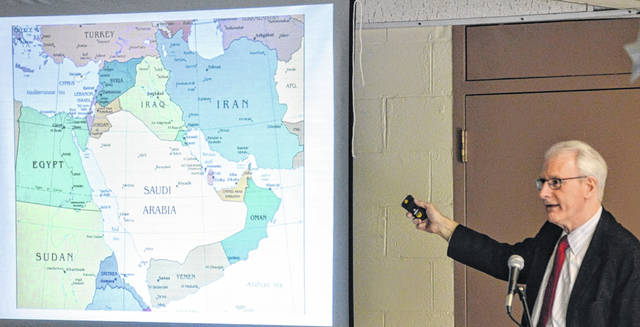
It would be difficult for many Americans to correctly label a map of the Middle East. And yet, the social tensions and events which happen 6,000 miles away shape U.S. foreign policy and trade on a daily basis.
On Friday, the first Great Decisions lecture of the year shed some light on the complex situations in the Middle East for interested Ohioans in Delaware.
In the basement of the William Street United Methodist Church in Delaware, Richard Herrmann addressed around 90 Delaware residents on the topic of regional disorder in the Middle East.
Herrmann is a professor and the chair of the Political Science Department at Ohio State University. He made a point of giving his talk without notes, saying that “if I can’t keep it in my head, you’ll never be able to keep it in yours.”
The audience listened attentively as Herrmann described the overlapping social, linguistic, and religious conflicts in the region which encompasses Yemen, Saudi Arabia, Iraq, Iran, Jordan and Turkey.
Herrmann simplified the region by identifying three major divisions: linguistic, religious and the urban-rural divide.
He explained that Arabs, Persians, Turks, Kurds and Azeris don’t look different physically, but distinguish themselves through language and dress. Kurds make up a large minority in Turkey and a smaller minority in northern Syria. They are the only ethno-linguistic group without a state of their own in the region.
Divisions within Islam are another factor in Middle East instability.
“The current (Trump) administration in particular is very hostile toward Shia Muslims in Iran,” Herrmann said. “These are the people they accuse of exporting radicalism around the world.”
Herrmann then presented a wider map of the Middle East, which showed the vast majority of Sunni-dominant countries in the region.
“Hopefully, this map can at least shed some light on why the Iranians may feel, you know, a bit surrounded.
“The urban-rural divide should be increasingly easy for Americans to understand,” Herrmann continued, “seeing as we have an increasingly deep division within our own country, with rural areas being very red and urban areas being, for the most part, very blue.”
Herrmann explained that the divide in Middle Eastern countries was between rural, deeply religious populations, and more secular populations in cities.
“I would guess that the U.S. government is one of the most popular world governments on the ground in Tehran,” Herrmann said, referencing the younger, cosmopolitan generation in Iran’s capital.
He also used the urban-rural divide to explain conflicts in Syria, where Bashar al-Assad still holds some urban support despite the recognized brutality of his regime.
Herrmann presented a map showing the Sunni majority in the north of Syria, where ISIS, which is led by Sunnis, is still strong. Damascus and Aleppo, the country’s major cities, are minority Shias like Assad.
“If you are an urban merchant in Damascus, you may have to choose between ISIS and Assad,” said Herrmann, which prompted concerned murmurs from the crowd. “The choice is clear.”
Herrmann took questions ranging from the role of Jordan in the region to oil in the Caspian Sea, which Herrmann said he believes will play a bigger role in Europe’s future than anything in the Middle East.
Jennifer Georgic, a Delaware resident who has attended Great Decisions lectures in the past, said she was glad she came, because she had always had difficulty understanding the divide between Sunnis and Shias.
“I think it’s valuable to hear some of the experts in the field, rather than just the general media,” she said. “I wish the talk was longer.”
The next lecture, on March 1, will feature Cantay Çaliskan, professor of mathematics and computer science at Ohio Wesleyan University. He will address cyber conflicts and geopolitics in U.S. foreign policy.


